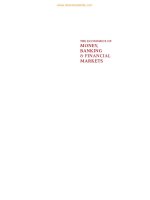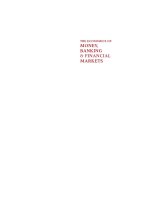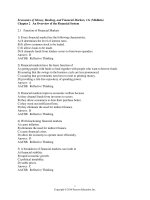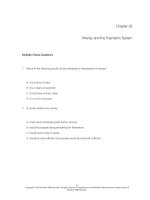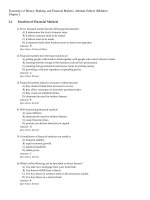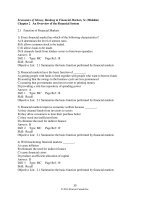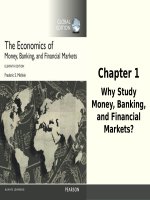Economics of money banking and financial markets 11th edition mishkin test bank
Bạn đang xem bản rút gọn của tài liệu. Xem và tải ngay bản đầy đủ của tài liệu tại đây (69.86 KB, 28 trang )
Economics of Money, Banking, and Financial Markets, 11e (Mishkin)
Chapter 2 An Overview of the Financial System
2.1 Function of Financial Markets
1) Every financial market has the following characteristic.
A) It determines the level of interest rates.
B) It allows common stock to be traded.
C) It allows loans to be made.
D) It channels funds from lenders-savers to borrowers-spenders.
Answer: D
AACSB: Reflective Thinking
2) Financial markets have the basic function of
A) getting people with funds to lend together with people who want to borrow funds.
B) assuring that the swings in the business cycle are less pronounced.
C) assuring that governments need never resort to printing money.
D) providing a risk-free repository of spending power.
Answer: A
AACSB: Reflective Thinking
3) Financial markets improve economic welfare because
A) they channel funds from investors to savers.
B) they allow consumers to time their purchase better.
C) they weed out inefficient firms.
D) they eliminate the need for indirect finance.
Answer: B
AACSB: Reflective Thinking
4) Well-functioning financial markets
A) cause inflation.
B) eliminate the need for indirect finance.
C) cause financial crises.
D) allow the economy to operate more efficiently.
Answer: D
AACSB: Reflective Thinking
5) A breakdown of financial markets can result in
A) financial stability.
B) rapid economic growth.
C) political instability.
D) stable prices.
Answer: C
AACSB: Reflective Thinking
1
Copyright © 2016 Pearson Education, Inc.
6) The principal lender-savers are
A) governments.
B) businesses.
C) households.
D) foreigners.
Answer: C
AACSB: Application of Knowledge
7) Which of the following can be described as direct finance?
A) You take out a mortgage from your local bank.
B) You borrow $2500 from a friend.
C) You buy shares of common stock in the secondary market.
D) You buy shares in a mutual fund.
Answer: B
AACSB: Analytical Thinking
8) Assume that you borrow $2000 at 10% annual interest to finance a new business project. For
this loan to be profitable, the minimum amount this project must generate in annual earnings is
A) $400.
B) $201.
C) $200.
D) $199.
Answer: B
AACSB: Analytical Thinking
9) You can borrow $5000 to finance a new business venture. This new venture will generate
annual earnings of $251. The maximum interest rate that you would pay on the borrowed funds
and still increase your income is
A) 25%.
B) 12.5%.
C) 10%.
D) 5%.
Answer: D
AACSB: Analytical Thinking
10) Which of the following can be described as involving direct finance?
A) A corporation issues new shares of stock.
B) People buy shares in a mutual fund.
C) A pension fund manager buys a short-term corporate security in the secondary market.
D) An insurance company buys shares of common stock in the over-the-counter markets.
Answer: A
AACSB: Analytical Thinking
2
Copyright © 2016 Pearson Education, Inc.
11) Which of the following can be described as involving direct finance?
A) A corporation takes out loans from a bank.
B) People buy shares in a mutual fund.
C) A corporation buys a short-term corporate security in a secondary market.
D) People buy shares of common stock in the primary markets.
Answer: D
AACSB: Analytical Thinking
12) Which of the following can be described as involving indirect finance?
A) You make a loan to your neighbor.
B) A corporation buys a share of common stock issued by another corporation in the primary
market.
C) You buy a U.S. Treasury bill from the U.S. Treasury at TreasuryDirect.gov.
D) You make a deposit at a bank.
Answer: D
AACSB: Analytical Thinking
13) Which of the following can be described as involving indirect finance?
A) You make a loan to your neighbor.
B) You buy shares in a mutual fund.
C) You buy a U.S. Treasury bill from the U.S. Treasury at Treasury Direct.gov.
D) You purchase shares in an initial public offering by a corporation in the primary market.
Answer: B
AACSB: Analytical Thinking
14) Securities are ________ for the person who buys them, but are ________ for the individual
or firm that issues them.
A) assets; liabilities
B) liabilities; assets
C) negotiable; nonnegotiable
D) nonnegotiable; negotiable
Answer: A
AACSB: Reflective Thinking
15) With ________ finance, borrowers obtain funds from lenders by selling them securities in
the financial markets.
A) active
B) determined
C) indirect
D) direct
Answer: D
AACSB: Application of Knowledge
3
Copyright © 2016 Pearson Education, Inc.
16) With direct finance, funds are channeled through the financial market from the ________
directly to the ________.
A) savers, spenders
B) spenders, investors
C) borrowers, savers
D) investors, savers
Answer: A
AACSB: Reflective Thinking
17) Distinguish between direct finance and indirect finance. Which of these is the most important
source of funds for corporations in the United States?
Answer: With direct finance, funds flow directly from the lender/saver to the borrower. With
indirect finance, funds flow from the lender/saver to a financial intermediary who then channels
the funds to the borrower/investor. Financial intermediaries (indirect finance) are the major
source of funds for corporations in the U.S.
AACSB: Reflective Thinking
2.2 Structure of Financial Markets
1) Which of the following statements about the characteristics of debt and equity is FALSE?
A) They can both be long-term financial instruments.
B) They can both be short-term financial instruments.
C) They both involve a claim on the issuer's income.
D) They both enable a corporation to raise funds.
Answer: B
AACSB: Reflective Thinking
2) Which of the following statements about the characteristics of debt and equities is TRUE?
A) They can both be long-term financial instruments.
B) Bond holders are residual claimants.
C) The income from bonds is typically more variable than that from equities.
D) Bonds pay dividends.
Answer: A
AACSB: Reflective Thinking
3) Which of the following statements about financial markets and securities is TRUE?
A) A bond is a long-term security that promises to make periodic payments called dividends to
the firm's residual claimants.
B) A debt instrument is intermediate term if its maturity is less than one year.
C) A debt instrument is intermediate term if its maturity is ten years or longer.
D) The maturity of a debt instrument is the number of years (term) to that instrument's expiration
date.
Answer: D
AACSB: Reflective Thinking
4
Copyright © 2016 Pearson Education, Inc.
4) Which of the following is an example of an intermediate-term debt?
A) a fifteen-year mortgage
B) a sixty-month car loan
C) a six-month loan from a finance company
D) a thirty-year U.S. Treasury bond
Answer: B
AACSB: Analytical Thinking
5) If the maturity of a debt instrument is less than one year, the debt is called
A) short-term.
B) intermediate-term.
C) long-term.
D) prima-term.
Answer: A
AACSB: Application of Knowledge
6) Long-term debt has a maturity that is
A) between one and ten years.
B) less than a year.
C) between five and ten years.
D) ten years or longer.
Answer: D
AACSB: Application of Knowledge
7) When I purchase ________, I own a portion of a firm and have the right to vote on issues
important to the firm and to elect its directors.
A) bonds
B) bills
C) notes
D) stock
Answer: D
AACSB: Application of Knowledge
8) Equity holders are a corporation's ________. That means the corporation must pay all of its
debt holders before it pays its equity holders.
A) debtors
B) brokers
C) residual claimants
D) underwriters
Answer: C
AACSB: Reflective Thinking
5
Copyright © 2016 Pearson Education, Inc.
9) Which of the following benefits directly from any increase in the corporation's profitability?
A) a bond holder
B) a commercial paper holder
C) a shareholder
D) a T-bill holder
Answer: C
AACSB: Reflective Thinking
10) A financial market in which previously issued securities can be resold is called a ________
market.
A) primary
B) secondary
C) tertiary
D) used securities
Answer: B
AACSB: Application of Knowledge
11) An important financial institution that assists in the initial sale of securities in the primary
market is the
A) investment bank.
B) commercial bank.
C) stock exchange.
D) brokerage house.
Answer: A
AACSB: Application of Knowledge
12) When an investment bank ________ securities, it guarantees a price for a corporation's
securities and then sells them to the public.
A) underwrites
B) undertakes
C) overwrites
D) overtakes
Answer: A
AACSB: Application of Knowledge
13) Which of the following is NOT a secondary market?
A) foreign exchange market
B) futures market
C) options market
D) IPO market
Answer: D
AACSB: Reflective Thinking
6
Copyright © 2016 Pearson Education, Inc.
14) ________ work in the secondary markets matching buyers with sellers of securities.
A) Dealers
B) Underwriters
C) Brokers
D) Claimants
Answer: C
AACSB: Application of Knowledge
15) A corporation acquires new funds only when its securities are sold in the
A) primary market by an investment bank.
B) primary market by a stock exchange broker.
C) secondary market by a securities dealer.
D) secondary market by a commercial bank.
Answer: A
AACSB: Reflective Thinking
16) A corporation acquires new funds only when its securities are sold in the
A) secondary market by an investment bank.
B) primary market by an investment bank.
C) secondary market by a stock exchange broker.
D) secondary market by a commercial bank.
Answer: B
AACSB: Reflective Thinking
17) An important function of secondary markets is to
A) make it easier to sell financial instruments to raise funds.
B) raise funds for corporations through the sale of securities.
C) make it easier for governments to raise taxes.
D) create a market for newly constructed houses.
Answer: A
AACSB: Reflective Thinking
18) Secondary markets make financial instruments more
A) solid.
B) vapid.
C) liquid.
D) risky.
Answer: C
AACSB: Reflective Thinking
19) A liquid asset is
A) an asset that can easily and quickly be sold to raise cash.
B) a share of an ocean resort.
C) difficult to resell.
D) always sold in an over-the-counter market.
Answer: A
AACSB: Reflective Thinking
7
Copyright © 2016 Pearson Education, Inc.
20) The higher a security's price in the secondary market the ________ funds a firm can raise by
selling securities in the ________ market.
A) more; primary
B) more; secondary
C) less; primary
D) less; secondary
Answer: A
AACSB: Reflective Thinking
21) When secondary market buyers and sellers of securities meet in one central location to
conduct trades the market is called a(n)
A) exchange.
B) over-the-counter market.
C) common market.
D) barter market.
Answer: A
AACSB: Application of Knowledge
22) In a(n) ________ market, dealers in different locations buy and sell securities to anyone who
comes to them and is willing to accept their prices.
A) exchange
B) over-the-counter
C) common
D) barter
Answer: B
AACSB: Application of Knowledge
23) Forty or so dealers establish a "market" in these securities by standing ready to buy and sell
them.
A) secondary stocks
B) surplus stocks
C) U.S. government bonds
D) common stocks
Answer: C
AACSB: Application of Knowledge
8
Copyright © 2016 Pearson Education, Inc.
24) Which of the following statements about financial markets and securities is TRUE?
A) Many common stocks are traded over-the-counter, although the largest corporations usually
have their shares traded at organized stock exchanges such as the New York Stock Exchange.
B) As a corporation gets a share of the broker's commission, a corporation acquires new funds
whenever its securities are sold.
C) Capital market securities are usually more widely traded than shorter-term securities and so
tend to be more liquid.
D) Prices of capital market securities are usually more stable than prices of money market
securities, and so are often used to hold temporary surplus funds of corporations.
Answer: A
AACSB: Reflective Thinking
25) A financial market in which only short-term debt instruments are traded is called the
________ market.
A) bond
B) money
C) capital
D) stock
Answer: B
AACSB: Analytical Thinking
26) Equity instruments are traded in the ________ market.
A) money
B) bond
C) capital
D) commodities
Answer: C
AACSB: Analytical Thinking
27) Because these securities are more liquid and generally have smaller price fluctuations,
corporations and banks use the ________ securities to earn interest on temporary surplus funds.
A) money market
B) capital market
C) bond market
D) stock market
Answer: A
AACSB: Reflective Thinking
28) Corporations receive funds when their stock is sold in the primary market. Why do
corporations pay attention to what is happening to their stock in the secondary market?
Answer: The existence of the secondary market makes their stock more liquid and the price in
the secondary market sets the price that the corporation would receive if they choose to sell more
stock in the primary market.
AACSB: Reflective Thinking
9
Copyright © 2016 Pearson Education, Inc.
29) Describe the two methods of organizing a secondary market.
Answer: A secondary market can be organized as an exchange where buyers and sellers meet in
one central location to conduct trades. An example of an exchange is the New York Stock
Exchange. A secondary market can also be organized as an over-the-counter market. In this type
of market, dealers in different locations buy and sell securities to anyone who comes to them and
is willing to accept their prices. An example of an over-the-counter market is the federal funds
market.
AACSB: Reflective Thinking
2.3 Financial Market Instruments
1) Prices of money market instruments undergo the least price fluctuations because of
A) the short terms to maturity for the securities.
B) the heavy regulations in the industry.
C) the price ceiling imposed by government regulators.
D) the lack of competition in the market.
Answer: A
AACSB: Reflective Thinking
2) U.S. Treasury bills pay no interest but are sold at a ________. That is, you will pay a lower
purchase price than the amount you receive at maturity.
A) premium
B) collateral
C) default
D) discount
Answer: D
AACSB: Analytical Thinking
3) U.S. Treasury bills are considered the safest of all money market instruments because there is
a low probability of
A) defeat.
B) default.
C) desertion.
D) demarcation.
Answer: B
AACSB: Analytical Thinking
4) A debt instrument sold by a bank to its depositors that pays annual interest of a given amount
and at maturity pays back the original purchase price is called
A) commercial paper.
B) a certificate of deposit.
C) a municipal bond.
D) federal funds.
Answer: B
AACSB: Analytical Thinking
10
Copyright © 2016 Pearson Education, Inc.
5) A short-term debt instrument issued by well-known corporations is called
A) commercial paper.
B) corporate bonds.
C) municipal bonds.
D) commercial mortgages.
Answer: A
AACSB: Analytical Thinking
6) ________ are short-term loans in which Treasury bills serve as collateral.
A) Repurchase agreements
B) Negotiable certificates of deposit
C) Federal funds
D) U.S. government agency securities
Answer: A
AACSB: Analytical Thinking
7) Collateral is ________ the lender receives if the borrower does not pay back the loan.
A) a liability
B) an asset
C) a present
D) an offering
Answer: B
AACSB: Analytical Thinking
8) Federal funds are
A) funds raised by the federal government in the bond market.
B) loans made by the Federal Reserve System to banks.
C) loans made by banks to the Federal Reserve System.
D) loans made by banks to each other.
Answer: D
AACSB: Analytical Thinking
9) An important source of short-term funds for commercial banks are ________ which can be
resold on the secondary market.
A) negotiable CDs
B) commercial paper
C) mortgage-backed securities
D) municipal bonds
Answer: A
AACSB: Application of Knowledge
11
Copyright © 2016 Pearson Education, Inc.
10) Which of the following are short-term financial instruments?
A) a repurchase agreement
B) a share of Walt Disney Corporation stock
C) a Treasury note with a maturity of four years
D) a residential mortgage
Answer: A
AACSB: Analytical Thinking
11) Which of the following instruments are traded in a money market?
A) state and local government bonds
B) U.S. Treasury bills
C) corporate bonds
D) U.S. government agency securities
Answer: B
AACSB: Analytical Thinking
12) Which of the following instruments are traded in a money market?
A) bank commercial loans
B) commercial paper
C) state and local government bonds
D) residential mortgages
Answer: B
AACSB: Analytical Thinking
13) Which of the following instruments is NOT traded in a money market?
A) residential mortgages
B) U.S. Treasury Bills
C) negotiable bank certificates of deposit
D) commercial paper
Answer: A
AACSB: Analytical Thinking
14) Bonds issued by state and local governments are called ________ bonds.
A) corporate
B) Treasury
C) municipal
D) commercial
Answer: C
AACSB: Application of Knowledge
12
Copyright © 2016 Pearson Education, Inc.
15) Equity and debt instruments with maturities greater than one year are called ________
market instruments.
A) capital
B) money
C) federal
D) benchmark
Answer: A
AACSB: Application of Knowledge
16) Which of the following is a long-term financial instrument?
A) a negotiable certificate of deposit
B) a repurchase agreement
C) a U.S. Treasury bond
D) a U.S. Treasury bill
Answer: C
AACSB: Analytical Thinking
17) Which of the following instruments are traded in a capital market?
A) U.S. Government agency securities
B) negotiable bank CDs
C) repurchase agreements
D) U.S. Treasury bills
Answer: A
AACSB: Analytical Thinking
18) Which of the following instruments are traded in a capital market?
A) corporate bonds
B) U.S. Treasury bills
C) negotiable bank CDs
D) repurchase agreements
Answer: A
AACSB: Analytical Thinking
19) Which of the following are NOT traded in a capital market?
A) U.S. government agency securities
B) state and local government bonds
C) repurchase agreements
D) corporate bonds
Answer: C
AACSB: Analytical Thinking
13
Copyright © 2016 Pearson Education, Inc.
20) The most liquid securities traded in the capital market are
A) corporate bonds.
B) municipal bonds.
C) U.S. Treasury bonds.
D) mortgage-backed securities.
Answer: C
AACSB: Reflective Thinking
21) Mortgage-backed securities are similar to ________ but the interest and principal payments
are backed by the individual mortgages within the security.
A) bonds
B) stock
C) repurchase agreements
D) negotiable CDs
Answer: A
AACSB: Application of Knowledge
2.4 Internationalization of Financial Markets
1) Equity of U.S. companies can be purchased by
A) U.S. citizens only.
B) foreign citizens only.
C) U.S. citizens and foreign citizens.
D) U.S. mutual funds only.
Answer: C
AACSB: Diverse and multicultural work environments
2) One reason for the extraordinary growth of foreign financial markets is
A) decreased trade.
B) increases in the pool of savings in foreign countries.
C) the recent introduction of the foreign bond.
D) slower technological innovation in foreign markets.
Answer: B
AACSB: Diverse and multicultural work environments
3) Bonds that are sold in a foreign country and are denominated in the country's currency in
which they are sold are known as
A) foreign bonds.
B) Eurobonds.
C) equity bonds.
D) country bonds.
Answer: A
AACSB: Application of Knowledge
14
Copyright © 2016 Pearson Education, Inc.
4) Bonds that are sold in a foreign country and are denominated in a currency other than that of
the country in which it is sold are known as
A) foreign bonds.
B) Eurobonds.
C) equity bonds.
D) country bonds.
Answer: B
AACSB: Application of Knowledge
5) If Microsoft sells a bond in London and it is denominated in dollars, the bond is a
A) Eurobond.
B) foreign bond.
C) British bond.
D) currency bond.
Answer: A
AACSB: Reflective Thinking
6) U.S. dollar deposits in foreign banks outside the U.S. or in foreign branches of U.S. banks are
called
A) Atlantic dollars.
B) Eurodollars.
C) foreign dollars.
D) outside dollars.
Answer: B
AACSB: Application of Knowledge
7) If Toyota sells a $1000 bond in the United States, the bond is a
A) foreign bond.
B) Eurobond.
C) Tokyo bond.
D) currency bond.
Answer: A
AACSB: Application of Knowledge
8) Distinguish between a foreign bond and a Eurobond.
Answer: A foreign bond is sold in a foreign country and priced in that country's currency. A
Eurobond is sold in a foreign country and priced in a currency that is not that country's currency.
AACSB: Reflective Thinking
15
Copyright © 2016 Pearson Education, Inc.
2.5 Function of Financial Intermediaries: Indirect Finance
1) The process of indirect finance using financial intermediaries is called
A) direct lending.
B) financial intermediation.
C) resource allocation.
D) financial liquidation.
Answer: B
AACSB: Reflective Thinking
2) In the United States, loans from ________ are far ________ important for corporate finance
than are securities markets.
A) government agencies; more
B) government agencies; less
C) financial intermediaries; more
D) financial intermediaries; less
Answer: C
AACSB: Reflective Thinking
3) The time and money spent in carrying out financial transactions are called
A) economies of scale.
B) financial intermediation.
C) liquidity services.
D) transaction costs.
Answer: D
AACSB: Application of Knowledge
4) Economies of scale enable financial institutions to
A) reduce transactions costs.
B) avoid the asymmetric information problem.
C) avoid adverse selection problems.
D) reduce moral hazard.
Answer: A
AACSB: Reflective Thinking
5) An example of economies of scale in the provision of financial services is
A) investing in a diversified collection of assets.
B) providing depositors with a variety of savings certificates.
C) hiring more support staff so that customers don't have to wait so long for assistance.
D) spreading the cost of writing a standardized contract over many borrowers.
Answer: D
AACSB: Reflective Thinking
16
Copyright © 2016 Pearson Education, Inc.
6) Financial intermediaries provide customers with liquidity services. Liquidity services
A) make it easier for customers to conduct transactions.
B) allow customers to have a cup of coffee while waiting in the lobby.
C) are a result of the asymmetric information problem.
D) are another term for asset transformation.
Answer: A
AACSB: Reflective Thinking
7) The process where financial intermediaries create and sell low-risk assets and use the proceeds
to purchase riskier assets is known as
A) risk sharing.
B) risk aversion.
C) risk neutrality.
D) risk selling.
Answer: A
AACSB: Analytical Thinking
8) The process of asset transformation refers to the conversion of
A) safer assets into risky assets.
B) safer assets into safer liabilities.
C) risky assets into safer assets.
D) risky assets into risky liabilities.
Answer: C
AACSB: Analytical Thinking
9) Reducing risk through the purchase of assets whose returns do not always move together is
A) diversification.
B) intermediation.
C) intervention.
D) discounting.
Answer: A
AACSB: Analytical Thinking
10) The concept of diversification is captured by the statement
A) don't look a gift horse in the mouth.
B) don't put all your eggs in one basket.
C) it never rains, but it pours.
D) make hay while the sun shines.
Answer: B
AACSB: Reflective Thinking
17
Copyright © 2016 Pearson Education, Inc.
11) Risk sharing is profitable for financial institutions due to
A) low transactions costs.
B) asymmetric information.
C) adverse selection.
D) moral hazard.
Answer: A
AACSB: Reflective Thinking
12) Typically, borrowers have superior information relative to lenders about the potential returns
and risks associated with an investment project. The difference in information is called
A) moral selection.
B) risk sharing.
C) asymmetric information.
D) adverse hazard.
Answer: C
AACSB: Analytical Thinking
13) If bad credit risks are the ones who most actively seek loans and, therefore, receive them
from financial intermediaries, then financial intermediaries face the problem of
A) moral hazard.
B) adverse selection.
C) free-riding.
D) costly state verification.
Answer: B
AACSB: Reflective Thinking
14) The problem created by asymmetric information before the transaction occurs is called
________, while the problem created after the transaction occurs is called ________.
A) adverse selection; moral hazard
B) moral hazard; adverse selection
C) costly state verification; free-riding
D) free-riding; costly state verification
Answer: A
AACSB: Application of Knowledge
15) Adverse selection is a problem associated with equity and debt contracts arising from
A) the lender's relative lack of information about the borrower's potential returns and risks of his
investment activities.
B) the lender's inability to legally require sufficient collateral to cover a 100% loss if the
borrower defaults.
C) the borrower's lack of incentive to seek a loan for highly risky investments.
D) the borrower's lack of good options for obtaining funds.
Answer: A
AACSB: Reflective Thinking
18
Copyright © 2016 Pearson Education, Inc.
16) An example of the problem of ________ is when a corporation uses the funds raised from
selling bonds to fund corporate expansion to pay for Caribbean cruises for all of its employees
and their families.
A) adverse selection
B) moral hazard
C) risk sharing
D) credit risk
Answer: B
AACSB: Ethical understanding and reasoning abilities
17) Banks can lower the cost of information production by applying one information resource to
many different services. This process is called
A) economies of scale.
B) asset transformation.
C) economies of scope.
D) asymmetric information.
Answer: C
AACSB: Application of Knowledge
18) Conflicts of interest are a type of ________ problem that can happen when an institution
provides multiple services.
A) adverse selection
B) free-riding
C) discounting
D) moral hazard
Answer: D
AACSB: Ethical understanding and reasoning abilities
19) Studies of the major developed countries show that when businesses go looking for funds to
finance their activities they usually obtain these funds from
A) government agencies.
B) equities markets.
C) financial intermediaries.
D) bond markets.
Answer: C
AACSB: Application of Knowledge
20) The countries that have made the least use of securities markets are ________ and ________;
in these two countries finance from financial intermediaries has been almost ten times greater
than that from securities markets.
A) Germany; Japan
B) Germany; Great Britain
C) Great Britain; Canada
D) Canada; Japan
Answer: A
AACSB: Application of Knowledge
19
Copyright © 2016 Pearson Education, Inc.
21) Although the dominance of ________ over ________ is clear in all countries, the relative
importance of bond versus stock markets differs widely.
A) financial intermediaries; securities markets
B) financial intermediaries; government agencies
C) government agencies; financial intermediaries
D) government agencies; securities markets
Answer: A
AACSB: Reflective Thinking
22) Because there is an imbalance of information in a lending situation, we must deal with the
problems of adverse selection and moral hazard. Define these terms and explain how financial
intermediaries can reduce these problems.
Answer: Adverse selection is the asymmetric information problem that exists before the
transaction occurs. For lenders, it is the difficulty in judging a good credit risk from a bad credit
risk. Moral hazard is the asymmetric information problem that exists after the transaction occurs.
For lenders, it is the difficulty in making sure the borrower uses the funds appropriately.
Financial intermediaries can reduce adverse selection through intensive screening and can reduce
moral hazard by monitoring the borrower.
AACSB: Reflective Thinking
2.6 Types of Financial Intermediaries
1) Financial institutions that accept deposits and make loans are called ________ institutions.
A) investment
B) contractual savings
C) depository
D) underwriting
Answer: C
AACSB: Application of Knowledge
2) Thrift institutions include
A) banks, mutual funds, and insurance companies.
B) savings and loan associations, mutual savings banks, and credit unions.
C) finance companies, mutual funds, and money market funds.
D) pension funds, mutual funds, and banks.
Answer: B
AACSB: Analytical Thinking
3) Which of the following is a depository institution?
A) a life insurance company
B) a credit union
C) a pension fund
D) a mutual fund
Answer: B
AACSB: Analytical Thinking
20
Copyright © 2016 Pearson Education, Inc.
4) Which of the following is a depository institution?
A) a life insurance company
B) a mutual savings bank
C) a pension fund
D) a finance company
Answer: B
AACSB: Analytical Thinking
5) Which of the following financial intermediaries is NOT a depository institution?
A) a savings and loan association
B) a commercial bank
C) a credit union
D) a finance company
Answer: D
AACSB: Analytical Thinking
6) The primary assets of credit unions are
A) municipal bonds.
B) business loans.
C) consumer loans.
D) mortgages.
Answer: C
AACSB: Analytical Thinking
7) The primary liabilities of a commercial bank are
A) bonds.
B) mortgages.
C) deposits.
D) commercial paper.
Answer: C
AACSB: Analytical Thinking
8) The primary liabilities of depository institutions are
A) premiums from policies.
B) shares.
C) deposits.
D) bonds.
Answer: C
AACSB: Analytical Thinking
21
Copyright © 2016 Pearson Education, Inc.
9) ________ institutions are financial intermediaries that acquire funds at periodic intervals on a
contractual basis.
A) Investment
B) Contractual savings
C) Thrift
D) Depository
Answer: B
AACSB: Application of Knowledge
10) Which of the following is a contractual savings institution?
A) a life insurance company
B) a credit union
C) a savings and loan association
D) a mutual fund
Answer: A
AACSB: Analytical Thinking
11) Contractual savings institutions include
A) mutual savings banks.
B) money market mutual funds.
C) commercial banks.
D) life insurance companies.
Answer: D
AACSB: Analytical Thinking
12) Which of the following are NOT contractual savings institutions?
A) life insurance companies
B) credit unions
C) pension funds
D) state and local government retirement funds
Answer: B
AACSB: Analytical Thinking
13) Which of the following is NOT a contractual savings institution?
A) a life insurance company
B) a pension fund
C) a savings and loan association
D) a fire and casualty insurance company
Answer: C
AACSB: Analytical Thinking
22
Copyright © 2016 Pearson Education, Inc.
14) The primary assets of a pension fund are
A) money market instruments.
B) corporate bonds and stock.
C) consumer and business loans.
D) mortgages.
Answer: B
AACSB: Analytical Thinking
15) Which of the following are investment intermediaries?
A) life insurance companies
B) mutual funds
C) pension funds
D) state and local government retirement funds
Answer: B
AACSB: Analytical Thinking
16) An investment intermediary that lends funds to consumers is
A) a finance company.
B) an investment bank.
C) a finance fund.
D) a consumer company.
Answer: A
AACSB: Application of Knowledge
17) The primary assets of a finance company are
A) municipal bonds.
B) corporate stocks and bonds.
C) consumer and business loans.
D) mortgages.
Answer: C
AACSB: Analytical Thinking
18) ________ are financial intermediaries that acquire funds by selling shares to many
individuals and using the proceeds to purchase diversified portfolios of stocks and bonds.
A) Mutual funds
B) Investment banks
C) Finance companies
D) Credit unions
Answer: A
AACSB: Analytical Thinking
23
Copyright © 2016 Pearson Education, Inc.
19) Money market mutual fund shares function like
A) checking accounts that pay interest.
B) bonds.
C) stocks.
D) currency.
Answer: A
AACSB: Reflective Thinking
20) An important feature of money market mutual fund shares is
A) deposit insurance.
B) the ability to write checks against shareholdings.
C) the ability to borrow against shareholdings.
D) claims on shares of corporate stock.
Answer: B
AACSB: Reflective Thinking
21) The primary assets of money market mutual funds are
A) stocks.
B) bonds.
C) money market instruments.
D) deposits.
Answer: C
AACSB: Analytical Thinking
22) An investment bank helps ________ issue securities.
A) a corporation
B) the United States government
C) the SEC
D) foreign governments
Answer: A
AACSB: Analytical Thinking
23) An investment bank purchases securities from a corporation at a predetermined price and
then resells them in the market. This process is called
A) underwriting.
B) underhanded.
C) understanding.
D) undertaking.
Answer: A
AACSB: Analytical Thinking
24
Copyright © 2016 Pearson Education, Inc.
24) A mutual fund that is organized as a limited partnership with high minimum investments is
called a
A) hedge fund.
B) investment bank.
C) mutual savings bank.
D) money market mutual fund.
Answer: A
AACSB: Application of Knowledge
25) Hedge funds require large minimum investments ranging from ________ to ________ or
more.
A) $100,000; $1 million
B) $1000; $10,000
C) $100; $1000
D) $$10,000; $25,000
Answer: A
AACSB: Application of Knowledge
26) The limited memberships and high dollar minimums for hedge funds means that these funds
are
A) subject to weaker regulation than other mutual funds.
B) more stringently regulated for fear of collapse.
C) limited in the types of assets they can purchase.
D) under the control of the U.S. Treasury.
Answer: A
AACSB: Application of Knowledge
2.7 Regulation of the Financial System
1) Which of the following is NOT a goal of financial regulation?
A) ensuring the soundness of the financial system
B) reducing moral hazard
C) reducing adverse selection
D) ensuring that investors never suffer losses
Answer: D
AACSB: Analytical Thinking
2) Increasing the amount of information available to investors helps to reduce the problems of
________ and ________ in the financial markets.
A) adverse selection; moral hazard
B) adverse selection; risk sharing
C) moral hazard; transactions costs
D) adverse selection; economies of scale
Answer: A
AACSB: Reflective Thinking
25
Copyright © 2016 Pearson Education, Inc.

